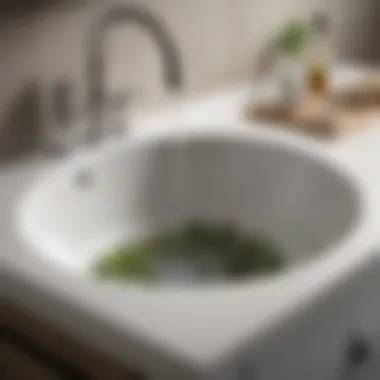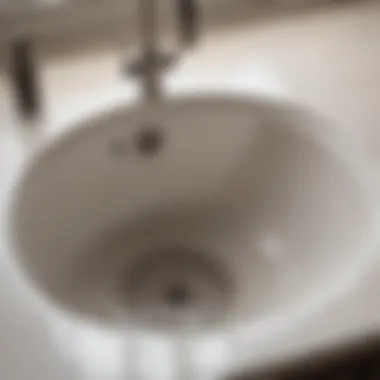Effective Homemade Remedies to Unclog Your Sink


Intro
Clogged sinks can be a persistent nuisance in any home. They disrupt daily activities and can even lead to more severe plumbing issues if ignored. This article explores various homemade remedies for unclogging sinks using common household items. The focus is on practicality and eco-friendliness, ensuring that homeowners can address clogs without relying on harsh chemical drain cleaners. We will discuss different methods, their effectiveness, potential challenges, and preventive measures to keep drains clear.
When faced with a clogged sink, several simple solutions can be applied immediately. These remedies often utilize ingredients that most households already have. They are cost-effective and less harmful to the environment than most commercial cleaners.
Baking Soda and Vinegar Method
The combination of baking soda and vinegar is a time-honored method for unclogging drains. Baking soda is a natural abrasive and deodorizer, while vinegar provides acidity that can dissolve grease and debris.
Steps to follow:
- Remove any standing water in the sink if possible.
- Pour 1 cup of baking soda down the drain, followed by 1 cup of vinegar.
- Cover the drain with a cloth or plug to keep the reaction from escaping.
- After 30 minutes, rinse with hot water to flush everything through.
This method not only helps to clear the drain but also cleans the plumbing with minimal effort.
Salt and Boiling Water Technique
Another effective technique involves using salt with boiling water. Salt can break down residue and grease clogs.
How to do this:
- Boil a kettle of water.
- While it’s boiling, pour about 1/2 cup of salt down the sink.
- Follow with the boiling water. This should work to dissolve minor clogs quickly.
Dish Soap Method
Dish soap is also useful, especially for grease clogs.
Procedure:
- Pour a good amount of dish soap directly into the drain.
- Let it sit for 15 minutes to break down the grease.
- Follow it up with hot water to flush the drain.
Preventive Measures
To avoid clogs in the future, certain practices can be implemented:
- Use a sink strainer to catch food particles.
- Avoid pouring grease down the sink.
- Regularly clean the drain with baking soda and vinegar as a preventative measure.
- Run hot water through the drain after each use to keep it clear.
Ending
In summary, unclogging a sink does not always require professional help or damaging chemicals. By utilizing commonly found items such as baking soda, vinegar, and salt, homeowners can effectively mitigate clogs. By understanding these techniques and practicing preventive maintenance, you can maintain a clear and functional drainage system.
Prologue
Clogged sinks are a common household issue that can disrupt daily routines. Understanding how to manage this problem effectively is crucial. Not only does it save time and money, but it also promotes a sustainable approach by reducing reliance on harsh chemicals. Homemade remedies offer practical, safe, and easy methods for unclogging sinks without damaging pipes or the environment. This article focuses on various effective remedies that everyone can access in their own homes.
Understanding Clogged Sinks
A sink can become clogged due to several reasons, with one predominant factor being the buildup of debris. Food particles, soap residue, and hair often accumulate in the drain, forming blockages. Over time, these buildups can lead to slow drainage or complete obstruction. Understanding these substances and their effects is essential for developing an effective unclogging strategy. The materials that compromise drain performance need careful consideration when selecting a remedy.
Why Opt for Homemade Remedies
There are numerous commercial products available for unclogging sinks, but many contain caustic chemicals. These products can pose risks to both your plumbing and health. In contrast, homemade remedies offer a safer alternative. They typically utilize common household items such as baking soda, vinegar, or salt, which are effective and eco-friendly.
Additionally, opting for these remedies often saves money. Instead of buying expensive, potentially harmful chemicals, you can solve your plumbing issues with items already in your cupboard. Embracing these methods can lead to a sense of empowerment and foster more sustainable living habits.


"Homemade remedies not only provide an effective solution but also promote self-sufficiency and environmental responsibility."
Lastly, the ease of access to these items simplifies the unclogging process. Most households will have these materials at hand, making it feasible to address a clogged sink promptly without too much hassle. Overall, employing homemade remedies slots into a broader context of responsible home maintenance, making it an appealing choice for homeowners.
Common Causes of Clogs
Understanding the common causes of clogged sinks is crucial for effective prevention and resolution measures. By identifying these issues, homeowners can take proactive steps, reducing the occurrence of frustrating plumbing problems. Recognizing the elements contributing to clogs will not only save time but also reduce reliance on chemical drain cleaners that can harm the environment and personal health.
Food Debris
Food debris is one of the leading culprits behind sink clogs. Residues from meals can easily accumulate in pipes, particularly if they are disposed of improperly. Items like grease, coffee grounds, and fibrous vegetables do not break down easily and tend to stick to the sides of pipes, leading to blockages.
When rinsing dishes, it is essential to scrape off any leftover food in a trash bin before washing. This simple action can significantly reduce the risk of clogs. Regular cleaning of kitchen sinks can also help to prevent buildup.
Soap Build-Up
Soap build-up is another significant factor contributing to clogged sinks. Traditional soap products can create a sticky residue that coats the insides of pipes. This residue can attract other substances in the drain, compounding the problem over time. A common example is dish soap, which can leave behind oils and fats that harden in the pipes.
To combat soap build-up, consider using biodegradable or low-residue soap options. It is also beneficial to flush the sink with hot water regularly, helping to dissolve any soap remnants that may be lingering in the drainage system.
Hair and Grease Accumulation
Hair combined with grease is a notorious cause of clogs, especially in bathroom sinks. Hair can snag on various surfaces within pipes, creating a net that collects oils and soap. As hair clumps together with other substances, it forms a significant blockage over time.
Using drain covers can help minimize hair entering the drain, while regular cleaning can keep the sink clear. Additionally, avoiding pouring grease down the drain will help mitigate this issue.
Key Takeaway: Understanding these common causes allows for better maintenance and immediate corrective action, ensuring a smoother plumbing experience.
Preparing for the Unclogging Process
Preparing for the unclogging process is a critical stage in addressing a clogged sink. A thoughtful approach ensures that you can tackle the issue efficiently and effectively, minimizing frustration and potential damage to your plumbing system. This phase sets the groundwork for a successful unclogging attempt, equipping you with the necessary tools and understanding of the process ahead.
Understanding what tools and materials are needed beforehand can save time and make the process smoother. Also, it allows you to gather all the essential supplies, reducing interruptions. Additionally, being aware of safety precautions can protect you and your plumbing from accidents and mishaps.
Taking these preparatory steps not only increases the likelihood of unclogging success but also establishes a sense of control over the situation. A carefully structured approach speaks to the importance of preparedness in home maintenance, leading to a more enjoyable and less stressful experience overall.
Tools and Materials Needed
Having the right tools is vital for an effective unclogging process. Here’s a list of commonly used tools and materials:
- Plunger: A standard tool for dislodging clogs.
- Baking Soda: A non-toxic natural remedy.
- Vinegar: Effective when combined with baking soda.
- Boiling Water: Useful for grease-related clogs.
- Dish Soap: Helpful in cutting through oily build-ups.
- Salt: Works well when mixed with baking soda.
- Plumbing Snake: A more advanced tool for tougher clogs.
- Wet/Dry Vacuum: Useful for removing water and debris.
Gathering these items before starting will facilitate a smoother unclogging process.
Safety Precautions
Safety should always be a priority during any home maintenance task. When unclogging a sink, consider the following precautions:
- Use Gloves: Protect your hands from harsh substances and bacteria.
- Ventilation: Ensure proper air circulation, especially if you use vinegar or baking soda, as these can produce gases when combined.
- Avoid Mixing Products: Never mix chemical drain cleaners with homemade remedies; this can create harmful reactions.
- Secure the Area: Keep the area around the sink clean and free of hazards to avoid slips or falls.
Following these safety measures can prevent accidents and make the unclogging experience much more effective. For more details on safety practices, consider reviewing articles at Wikipedia or visiting forums like Reddit.
In summary, taking the time to prepare for the unclogging process empowers you to approach the task with confidence. With the right tools and a clear understanding of safety, you are set up for success in resolving that troublesome clog.
Effective Homemade Remedies
Effective homemade remedies provide a resourceful approach to addressing a common household issue—clogged sinks. They not only offer accessible solutions utilizing items typically found in your home but also promote environmentally friendly practices. This significance lies in reducing dependence on chemical drain cleaners, which can harm both plumbing systems and the environment. Moreover, these methods focus on practicality, making them applicable to diverse situations homeowners may encounter. The remedies discussed in this section are straightforward and economical, allowing individuals to tackle clogs effectively without the need for professional assistance.


Baking Soda and Vinegar
Using baking soda and vinegar is among the most popular methods for unclogging a sink. This combination creates a chemical reaction that helps to break down blockages. Start by pouring half a cup of baking soda down the drain, followed by half a cup of vinegar. The fizzy reaction that ensues can dislodge stubborn debris and grease. Allow the mixture to sit for at least 30 minutes, then flush the drain with hot water. This technique is particularly useful for recurring clogs as part of a regular maintenance routine.
Boiling Water Technique
The boiling water technique is one of the simplest methods you can employ to clear a clogged sink. Begin by boiling a kettle or pot of water. Once it reaches a rolling boil, carefully pour the water directly down the drain in stages. This method is effective at dissolving soap or grease build-up, which is often a major contributor to clogs. Repeat this process a couple of times if necessary for persistent blockages. It’s an easy solution that shows immediate results with minimal effort.
Salt and Baking Soda Mixture
Combining salt with baking soda can provide an effective remedy for sink clogs. For this remedy, mix a quarter cup of salt with a quarter cup of baking soda and pour it down the drain. The salt adds an abrasive element to the mixture, enhancing the effectiveness of the baking soda. Follow this by pouring hot water to help flush the contents down the pipe. This remedy not only targets clogs but also aids in deodorizing the drain.
Dish Soap and Hot Water
Dish soap is a common household item that can be surprisingly effective at unclogging sinks. Begin by squirting a generous amount of dish soap into the drain, followed by boiling hot water. The soap helps to lubricate the clog and disintegrate oily substances. After pouring in the hot water, allow it to sit for several minutes. This method is particularly effective when dealing with greasy clogs typically resulting from food waste.
Plunger Use
Using a plunger can often be a straightforward and effective approach to unclogging sinks. Make sure to choose a plunger designed for sinks, as it provides a tighter seal. Position it over the drain and push down firmly, then pull up sharply. This action creates pressure that can help dislodge clogs. Repeat the process several times as needed. It’s essential to ensure there is enough water in the sink to cover the base of the plunger for optimal effectiveness.
Effective homemade remedies offer a straightforward and budget-friendly alternative to conventional methods for unclogging your sink. They provide both immediate relief and long-term benefits.
Utilizing these methods can create a practical toolkit for homeowners facing the frequent nuisance of clogging sinks. Regular application of these strategies promotes overall well-being for your plumbing system while fostering a sustainable lifestyle.
Advanced Techniques
Advanced techniques for unclogging sinks offer homeowners effective solutions that go beyond the basics. While homemade remedies often provide immediate relief, there are situations where deeper intervention is necessary. Whether the clog is particularly stubborn or inaccessible, these advanced methods can make a significant difference in restoring water flow.
Understanding the use of specialized tools or methods is crucial. Utilizing a plumbing snake or the wet/dry vacuum method can eliminate more serious blockages. These approaches require different levels of technical skill, but they can be very effective in resolving persistent drainage issues.
Using a Plumbing Snake
A plumbing snake, also known as a drain auger, is a flexible tool designed to reach deep into the plumbing system. This device is especially useful for tough clogs that go beyond what household remedies can remedy.
To use a plumbing snake effectively, follow these steps:
- Insert the Snake: Place the end of the plumbing snake into the drain. Gently push it until you feel resistance.
- Twist and Push: Rotate the handle while pushing forward. This helps the snake to break apart or hook onto the obstruction.
- Pull Back: Once you feel it snag the clog, pull the snake back out carefully. This may require some force.
- Flush with Water: After removing the clog, run hot water down the drain to clear any remaining debris.
This technique requires some patience and physical effort, but it can be very rewarding when done correctly. However, if you encounter severe resistance or are unsure, it may be prudent to consult a professional.
Wet/Dry Vacuum Method
Using a wet/dry vacuum is another advanced approach to unclogging sinks. This device can provide powerful suction that may remove clogs effectively. Here’s how to proceed:
- Prepare the Vacuum: Set the vacuum to the liquid mode if needed. Make sure to remove any filters that can be damaged by water.
- Create a Seal: Let the vacuum hose fit snugly over the drain opening. To improve suction, you may use a wet rag or cloth to create a tighter seal.
- Turn on the Vacuum: Switch on the vacuum to create a strong suction force. Let it run for several minutes.
- Check for Results: After a few minutes, turn off the vacuum and check if the clog has cleared. Run water down the drain to see if it flows freely.
This method can be very effective, especially for clogs caused by larger debris or accumulated sludge. It is a tool that most homeowners can utilize, provided they follow safety guidelines and proper usage instructions.
Remember that not all clogs are accessible with these tools. If problems persist, seeking professional help may be necessary.
Troubleshooting Common Issues
Troubleshooting common issues related to clogged sinks is crucial for anyone looking to maintain a smoothly functioning drainage system. Understanding these problems can save time and eliminate frustration. By diagnosing issues properly, one can often find quick solutions. This section delves into two prevalent problems: persistent clogs and overflows. Both require careful consideration and appropriate responses for effective resolution.
Persistent Clogs


Persistent clogs can be particularly frustrating. These clogs occur when debris accumulates over time, creating a sustained blockage. Common symptoms include slow drainage or completely blocked sinks. For homeowners, tackling a persistent clog may require a multi-faceted approach.
- Assess the Severity: First, evaluate how serious the blockage is. Is it just one sink or multiple? A singular issue may be easier to address compared to systemic failures.
- Use Homemade Remedies Again: If previous methods like baking soda and vinegar were not effective, try them again. Sometimes, repeated applications can help break down stubborn deposits.
- Try Advanced Techniques: If traditional methods fail, consider using a plumbing snake. This tool can reach deeper into pipes to clear out more significant blockages.
If these steps do not resolve the issue, it may be time to consult with a professional plumber. Persistent clogs could indicate larger problems within the plumbing system that are not easily resolved with home remedies.
Overflows and Backups
Overflows and backups present another level of urgency in clogged sinks. When water backs up, it can lead to significant messes that require immediate attention. Recognizing the signs of these issues is paramount.
- Identifying Overflows: Keep an eye out for water spilling over from the sink. This typically happens when the drain is completely blocked.
- Immediate Action Needed: In the event of an overflow, turn off the water supply to the sink to prevent further flooding. This prevents additional water from exacerbating the situation.
- Emergency Clean-Up: After stopping the water flow, clean up spills immediately to prevent water damage. It is necessary to act quickly to protect cabinets and flooring under the sink.
To resolve backups, follow these steps:
- Check for Visible Blockages: Sometimes, you may see food or other debris trapped at the drain's entrance. Remove it cautiously.
- Reapplication of Remedies: Use a mix of baking soda and vinegar again to clear pipes if no visible blockage is evident.
- Consider a Wet/Dry Vacuum: If the sink is still overflowing, using a wet/dry vacuum can help suck out the standing water and any debris causing the backup.
"Being proactive about sink maintenance can prevent these issues before they arise. Regular checks and cleaning can go a long way in avoiding persistent clogs and emergency overflows."
Preventive Measures
Preventive measures are essential for maintaining the functionality of your sink and avoiding costly plumbing issues. Routine upkeep helps to minimize the risk of clogs and ensures that water flows smoothly. Engaging in simple practices can extend the lifespan of your plumbing and prevent unnecessary repairs. This section outlines two primary aspects of preventive care: regular maintenance practices and proper waste disposal.
Regular Maintenance Practices
Regular maintenance is a proactive approach to keeping your sink free from clogs. Allocating time for routine checks can pay dividends in the long run. Below are some key practices to implement:
- Routine hot water flushing: Periodically pouring hot water down the drain helps to dissolve grease and soap residues that may accumulate over time.
- Cleaning the drain strainer: Remove any food particles and debris from the drain strainer regularly to prevent buildup that leads to clogs.
- Use of biodegradable cleaners: Consider using natural cleaners like vinegar or baking soda to clean pipes instead of harsh chemicals that might damage plumbing.
- Monitor suspicious signs: Pay attention to slow drainage or unusual noises in your sink. Rectifying these issues early can prevent major clogs.
Setting reminders for these tasks can help maintain a smooth workflow and create a healthier plumbing system.
Proper Disposal of Waste
Waste disposal plays a significant role in preventing sink clogs. Educating yourself and others in your home about proper disposal practices can make a notable difference. Consider the following tips:
- Avoid flushing non-biodegradable items: Items like wipes, and dental floss should never be flushed down the sink.
- Handle grease carefully: Instead of pouring grease down the drain, collect it in a container until it solidifies, then dispose of it in the trash.
- Be mindful of food scraps: Use a compost bin for vegetable scraps instead of letting them go down the sink, which can accumulate and cause issues.
Good waste disposal habits not only keep your sink clean but also protect the environment. This is essential for maintaining a sustainable household.
When in doubt, remember that keeping your plumbing system free of foreign objects will always be the best strategy for prevention.
By incorporating these preventive measures into your routine, you can significantly reduce the chances of encountering clogged sinks in the future.
The End
In the closing section of this article, it is essential to reflect on the significance of the methods presented for unclogging sinks. Throughout our exploration, we have focused on practical homemade remedies that individuals can use without resorting to harsh chemicals. This not only aids in effectively clearing clogs but also promotes a healthier home environment.
Recap of Methods
The article has introduced several techniques for tackling sink clogs. Here’s a brief overview of the methods discussed:
- Baking Soda and Vinegar: A classic combination that creates a fizzy reaction, helping to dislodge minor clogs.
- Boiling Water Technique: This simple method can dissolve grease and soap buildup quickly.
- Salt and Baking Soda Mixture: This combination offers a powerful abrasive action against stubborn clogs.
- Dish Soap and Hot Water: Useful for oily buildups, dish soap helps to break down grease when paired with boiling water.
- Plunger Use: A tried-and-true tool for all sorts of clogs, capable of creating the necessary pressure to free blockages.
- Using a Plumbing Snake: An effective tool for reaching deep clogs that other methods cannot resolve.
- Wet/Dry Vacuum Method: A technical approach that suctions out clogs not accessible by simpler methods.
These methods not only offer effective solutions but are also easy to implement using commonly found household items. Such accessibility ensures that homeowners are equipped to handle minor plumbing issues as they arise.
Emphasis on Sustainable Practicess
The emphasis on sustainable practices throughout this article cannot be overstated. The remedies discussed are not reliant on harmful chemicals that can pose risks to both health and the environment. By choosing homemade treatments, individuals make a conscious choice to protect waterways and ecosystems from hazardous waste materials.
Utilizing household ingredients, such as baking soda, vinegar, and salt, aligns with a more eco-conscious approach to home maintenance. This practice encourages consumers to be mindful of their impact on the planet and promotes a more sustainable lifestyle.
"Opting for natural solutions reflects a modern understanding of responsibility in our everyday choices."
In summary, the methods and perspectives outlined here serve to empower homeowners. They are not only effective but align with a bigger picture of health and sustainability. As we conclude, it is clear that unclogging a sink need not be a daunting task. With the right knowledge and resources, maintaining clear drains can be straightforward and environmentally friendly.















